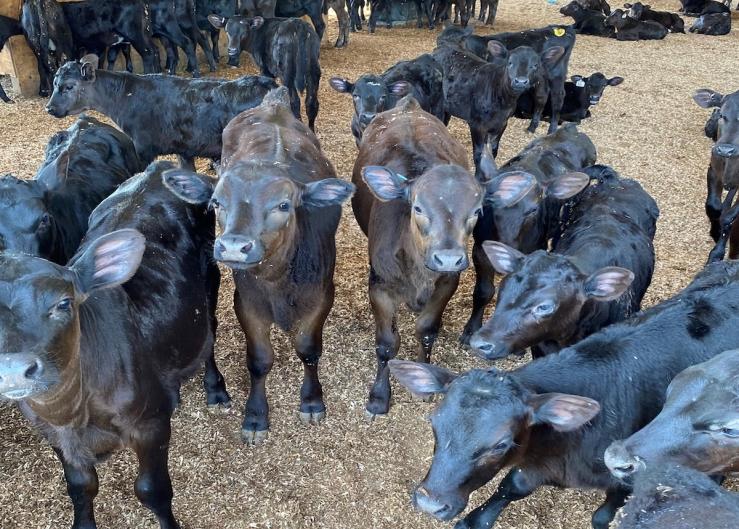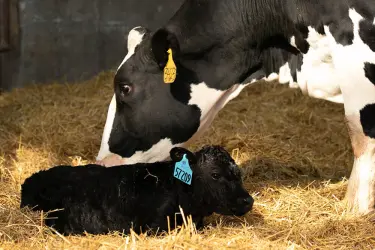Explore how Holstein dairy cows can give birth to beef crossbred calves safely, ensuring no health risks are posed to the cows. Can this crossbreeding strategy boost dairy farm profitability? Discover the unexpected advantages.

Dairy producers in contemporary farming are always looking for methods to increase sustainability and profitability. One promising approach to adding value to extra calves is crossbreeding Holstein dairy cows with cattle breed bulls. This strategy, with its potential benefits, offers a hopeful future for dairy farming.
While the inclusion of beef crossbred calves can indeed boost dairy farmers’ income due to their superior meat quality and higher selling price, the potential risks associated with their larger size and their impact on the health of the dairy cows bearing them should not be overlooked.
Bailey Basiel, lead author of a new Penn State University study, said, “The main concern is whether bigger beef crossbred calves could pose risks during gestation and birthing.”
From 2010 to 2023, the Penn State study team meticulously examined around 40,000 cows from dairy farms throughout the Northeast and Midwest. Their research is of significant importance, as it provides crucial new perspectives for dairy producers considering the crossbreeding technique.
Revolutionizing Dairy: Crossbreeding Holstein Cows with Beef Bulls Shows Promising Results
Penn State University researchers examined around 40,000 dairy cows from 10 farms throughout the Northeast and Midwest US over 13 years. Observing calf survival rates, gestational lengths (which were found to be extended in cows bearing beef-sired calves), and post-calving health, they assessed the results of crossbreeding Holstein cows with beef-breed bulls.
According to the research, crossbred beef calves exhibited comparable survival rates and no appreciable rise in dystocia compared to Holstein-sired calves. Moreover, the lactation performance and general health of cows bearing beef-sired calves showed no variations from those bearing Holstein-sired calves. This suggests that dairy farms may safely embrace crossbreeding with beef breeds without compromising cow health or production.
Calf Survival Rates: A Promising Yet Nuanced Outcome in Crossbreeding
One key finding of this research is the robustness of calves born from beef bulls, as indicated by their survival rates. These beef-sired calves showed birth survival rates on par with their Holstein-sired counterparts, underscoring the feasibility of crossbreeding from a survival perspective. However, it’s important to note that calves produced by crossbred beef bulls exhibited reduced survival rates, highlighting the need for careful breed selection to avoid unintended effects on calf survival rates.
Consistent Calving Outcomes Mitigate Crossbreeding Concerns
Key results showed that whether cows carried Holstein-sired or beef-sired calves, the likelihood of dystocia or painful delivery remains constant. This helps avoid worries about crossbreeding, which may cause more childbirth difficulties. Furthermore, clinically, there were no significant variations between the two groups after calving. Similar early lactation termination rates suggest that crossbreeding has no adverse effect on the early stages of milk output. These revelations comfort dairy farmers that crossbreeding is a workable solution to improve the value of extra calves.
Extended Gestation Periods: A Critical Consideration for Dairy Management
Productivity and dairy management are strongly influenced by gestational duration. The research found that cows bearing beef-sired calves had different gestation times than those bearing Holstein-sired calves. This knowledge empowers farmers to plan longer pregnancies, ensuring they can preserve cow and calf health.
Harnessing Extended Gestation Insights: A Pathway to Enhanced Dairy Farm Management
Bailey Basiel emphasized the need to know how various breeds affect gestation durations. ” This helps dairy producers plan for longer pregnancies and make necessary adjustments in feeding, labor, and care.”
Extended gestation durations seen in cows with Limousin and Wagyu-sired calves—which may span five and eight days—allow farmers the opportunity to prepare enough. “With this forward view, they can ensure cows receive appropriate nutrition and care during longer pregnancies,” she said.
She said, “These results provide important data that may improve the financial feasibility of dairy companies and cow condition. Depending on gestation durations and other criteria, dairy companies may match breeding programs with market needs and animal health concerns by choosing beef sires.
The Critical Role of Multiparous Cows in Crossbreeding Studies
It is very vital in our work to concentrate on multiparous cows. Having previously delivered, these cows provide a consistent dataset for examining the impacts of carrying and delivering crossbred beef calves. Because of the physiological hurdles experienced during the first calving, such as the need for more intensive care and the higher risk of health complications, first-time delivery is often more stressful. The research reduces the dangers of first-time deliveries by focusing on multiparous cows, therefore offering a better understanding of the more comprehensive health and lactation effects. This method guarantees that results are not affected by typical problems in first-time calvings and provides more accurate information for dairy farmers thinking about beef genetics in their herds.
Equilibrium in Milk Production: Crossbreeding Without Compromising Dairy Yields
Another essential consideration was milk output, particularly protein and fat yields. In these regards, Penn State researchers discovered no variations between heifers carrying Holstein-sired calves and those carrying beef-sired calves. This result emphasizes how milk quantity or quality is not sacrificed when creating beef crossbred calves. Dairy producers mostly rely on milk production for revenue; hence, this comfort is essential. This data enables dairy companies to improve calf value without sacrificing their main business as beef-dairy crossbreeding becomes popular.
Expanding Horizons: Crossbreeding Research to Include Jersey Cows
To see if these more miniature dairy cattle may safely generate beef crossbred calves without health problems or milk output losses, the study team intends to investigate crossbreeding with Jersey cows going ahead. By enabling breeds like Jersey to contribute value via beef crossbreds, this research might increase crossbreeding methods within the dairy sector. The outcomes may improve crossbreeding techniques, expanding the dairy industry’s adaptability and resilience.
The Bottom Line
Including beef-dairy sire choice in the US dairy market does not compromise the health of dairy cows. Covering a decade and over 40,000 cows, the research reveals steady measures, including dystocia, post-calving health events, and lactation performance whether cows bore Holstein or beef-sired calves. Published in the Journal of Dairy Science, these results provide dairy farmers with the confidence to pursue crossbreeding techniques, improving calf value without affecting herd health.
Key Takeaways:
- Calves sired by beef bulls share comparable birth survival rates with those sired by Holstein bulls, except for those sired by crossbred beef bulls.
- The incidence of dystocia or difficult births does not vary significantly between beef-sired and Holstein-sired calves.
- Post-calving clinical health and early lactation termination rates exhibit no substantial difference between cows carrying beef-sired and Holstein-sired calves.
- Cows bearing beef-sired calves experience longer gestation periods, particularly with Limousin and Wagyu bulls, extending the timeframe by 5 and 8 days respectively.
- Multiparous Holstein cows demonstrate consistent calving ease and low stillbirth rates, irrespective of the calf’s sire breed.
- Milk yield metrics, including total milk, milk fat, and milk protein, remain unaffected by the sire breed of the calves.
Summary:
Penn State University’s research on crossbreeding Holstein dairy cows with cattle breed bulls has yielded promising results. The study, which surveyed around 40,000 cows from 10 farms in the Northeast and Midwest US over 13 years, found that crossbred beef calves had comparable survival rates and no significant increase in dystocia compared to Holstein-sired calves. Lactation performance and general health of cows bearing beef-sired calves showed no variations from those bearing Holstein-sired calves, suggesting that dairy farms can safely embrace crossbreeding without compromising cow health or production. The study also found that the likelihood of dystocia or painful delivery remains constant for both Holstein-sired and beef-sired calves. However, crossbred beef bulls produced reduced survival rates, highlighting the need for careful breed selection. The research also highlighted the importance of multiparous cows in crossbreeding studies.
 Download “The Ultimate Dairy Breeders Guide to Beef on Dairy Integration” Now!
Download “The Ultimate Dairy Breeders Guide to Beef on Dairy Integration” Now!
Are you eager to discover the benefits of integrating beef genetics into your dairy herd? “The Ultimate Dairy Breeders Guide to Beef on Dairy Integration” is your key to enhancing productivity and profitability. This guide is explicitly designed for progressive dairy breeders, from choosing the best beef breeds for dairy integration to advanced genetic selection tips. Get practical management practices to elevate your breeding program. Understand the use of proven beef sires, from selection to offspring performance. Gain actionable insights through expert advice and real-world case studies. Learn about marketing, financial planning, and market assessment to maximize profitability. Dive into the world of beef-on-dairy integration. Leverage the latest genetic tools and technologies to enhance your livestock quality. By the end of this guide, you’ll make informed decisions, boost farm efficiency, and effectively diversify your business. Embark on this journey with us and unlock the full potential of your dairy herd with beef-on-dairy integration. Get Started!













